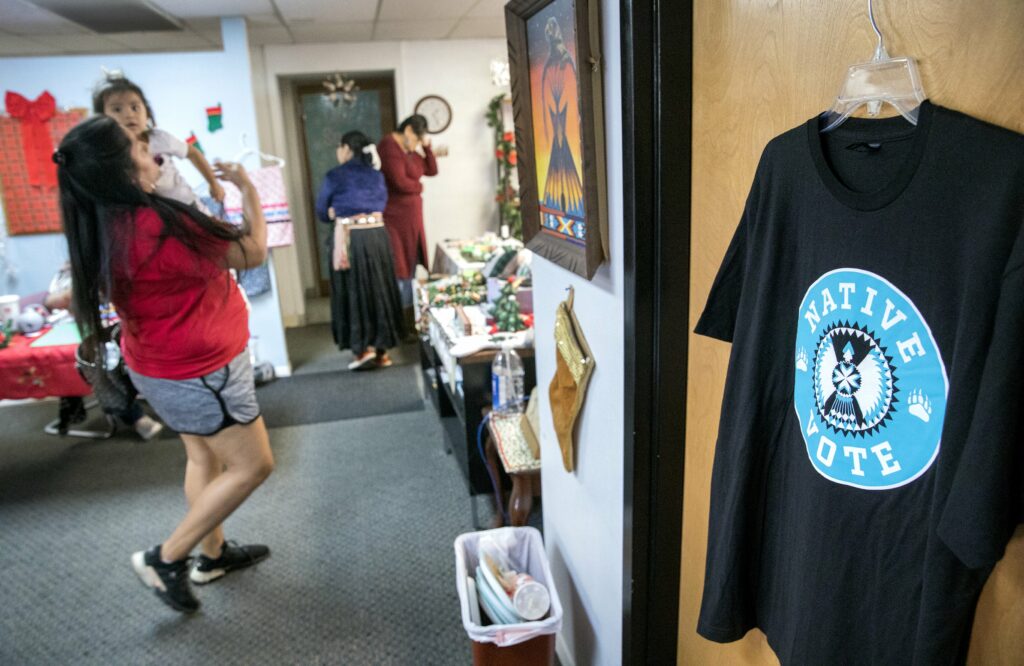Indian Country, long an afterthought in campaigns, is positioning itself as a force to be reckoned with in 2020
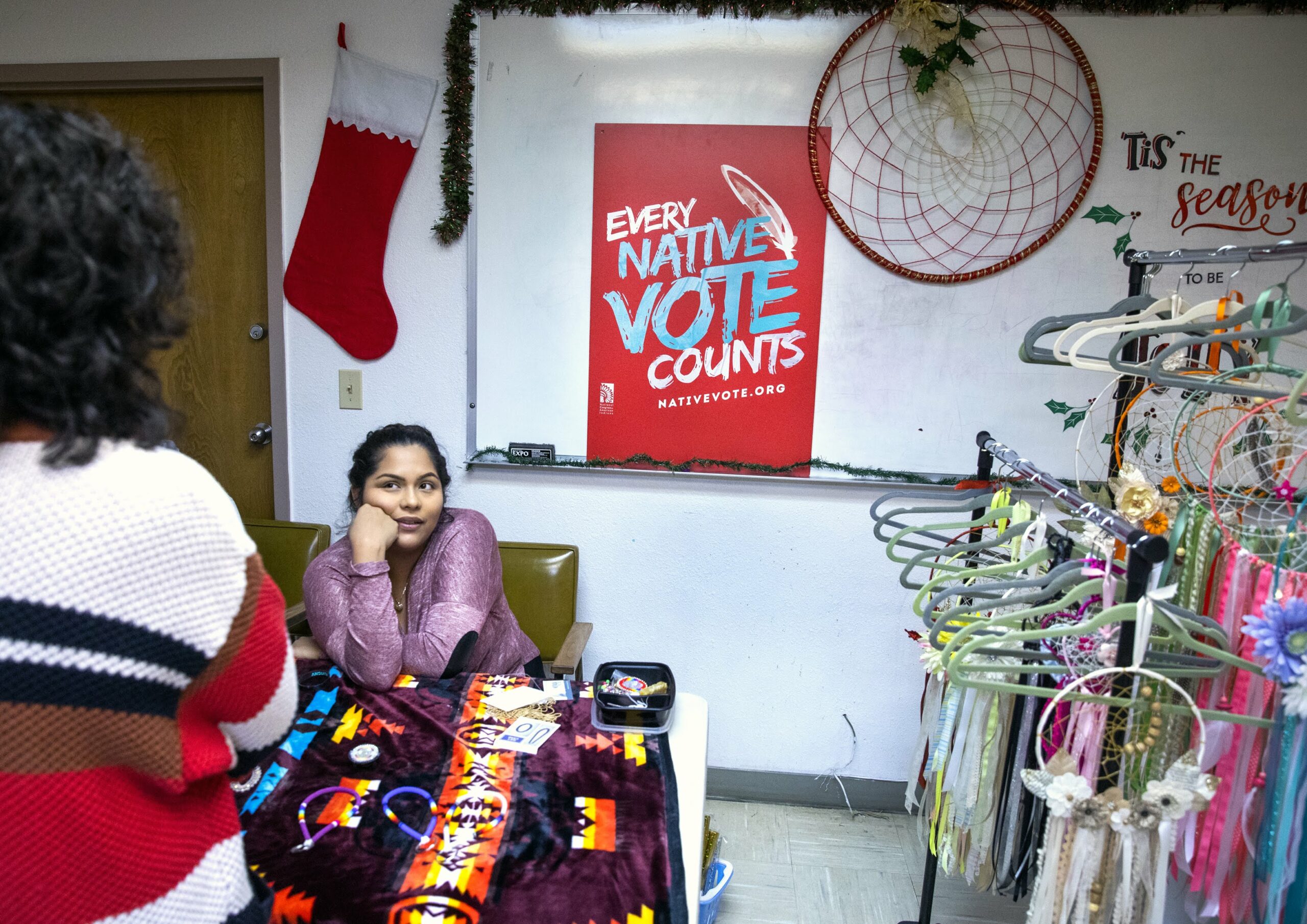
Long before the casinos, mines and brothels, long before Las Vegas, Reno and Elko, and long before the snow-capped mountains earned this land the name Nevada, there were the Washoe, Paiute and Shoshone people.
For centuries, they have called the Great Basin home. They gathered pinyon pine nuts before the silver-rich Comstock Lode was discovered, creating a crushing demand for the trees that were used to fuel mining operations. The Paiute fished the Cui-ui from Pyramid Lake before its water was diverted for agriculture. They drank the water before there were any mines or hazardous chemical runoff to worry about.
For generations, they and the rest of Indian Country have largely eschewed U.S. politics, distrustful of a government that waged war against them, allowed them to be enslaved, polluted the land and, to this day, fails to live up to its treaty obligations to them. They have also long been physically excluded from that political system, with the nearest polling sites to reservations sometimes hundreds of miles away.
Now, fueled by a renewed sense of agency after the Dakota access pipeline protests at Standing Rock in 2016 and 2017 and recent electoral victories, including the election of Rep. Deb Haaland and Rep. Sharice Davids as the first two Native American women to serve in Congress, Native leaders say they’re preparing to make a stand in the 2020 election — starting with Nevada’s Democratic presidential caucus in February.
Their message to presidential hopefuls is simple: The Native vote matters too.
“So much of the political system has ignored the Indian vote,” said Judith LeBlanc, director of the Native Organizers Alliance and a member of the Caddo Tribe of Oklahoma. “That is changing.”
It’s not just that it matters because Native voices should matter. Votes from tribal communities could actually be the margin of difference in Nevada, both in the state’s Democratic presidential caucus in February and the general election in November.
Indigenous people make up nearly 2 percent of the state’s population, with significant pockets living on reservations in rural Nevada, and the voting rights organization Four Directions estimates that the Native voting age population in Nevada will be nearly 67,000 by the time of the 2020 election, though it’s unclear how many are registered to vote.
It’s a fact that presidential hopefuls are keenly aware of. Candidates have sent representatives to the Inter-Tribal Council of Nevada, released Native-specific policies and even used their bully pulpits to draw attention to issues affecting Indian Country here, including a longstanding proposal to construct a long-term, high-level nuclear waste repository at Yucca Mountain, which is sacred to the Shoshone and Paiute peoples, and contamination related to the Anaconda Copper Mine outside of Yerington.
“I think there’s an increase in outreach to Indian Country. I’ve noticed that since the last election,” said Laurie Thom, chairman of the Yerington Paiute Tribe. “I think there’s been more activity, and they’re more proactive in reaching out to the tribal leaders.”
But not all candidate outreach has been equal — or received equally. Several tribal leaders in Nevada named Vermont Sen. Bernie Sanders as the candidate most fluent in Native American issues, and some have even endorsed him, citing a longstanding commitment to Native communities and the efforts he has made to meet with them during trips to the state. Massachusetts Sen. Elizabeth Warren has also received a prominent endorsement from a tribal chairman in the state.
Others liked California Sen. Kamala Harris, who dropped out of the race last month, said that she evolved on Native issues over the course of the campaign after clashing with California tribes in her prior post as the state’s attorney general. Some are fond of former Secretary of Housing and Urban Development Julián Castro and self-help author Marianne Williamson.
Native leaders appreciate the outreach from candidates, but it’s a two-way street. They want to be invited to presidential candidates’ events, but they want candidates to come to their events, too.
To that end, they’re planning a Native American presidential forum at UNLV in mid-January, which will bring together leaders from Nevada’s 27 tribes as well as those from surrounding states to hear from Democratic presidential hopefuls, attend planning meetings on how to turn out the Native vote nationally and host caucus trainings.
The forum will be the second-ever of its kind — the first was hosted in Sioux City, Iowa in August — but organizers say the Native vote isn’t going to make a difference in Iowa, where just 0.5 percent of the population identifies as American Indian or Alaska Native. It could in Nevada.
The Native vote isn’t a monolith, but experts say that it tends to lean blue. And with the way that delegate math works in the presidential caucus, winning rural Nevada could be the key to victory in a close race — just ask Barack Obama, who lost the popular vote in Nevada in 2008 but came out of the state with the most delegates, largely because of his organizing in rural portions of the state.
And in a small turnout election — 118,000 Democrats caucused in Nevada in 2008 and 84,000 in 2016 — every vote counts.
“I think the candidates are actually considering and thinking about tribes,” said Alan Mandell, vice chairman of the Pyramid Lake Paiute Tribe. “In a caucus state like us, it could make a good difference.”
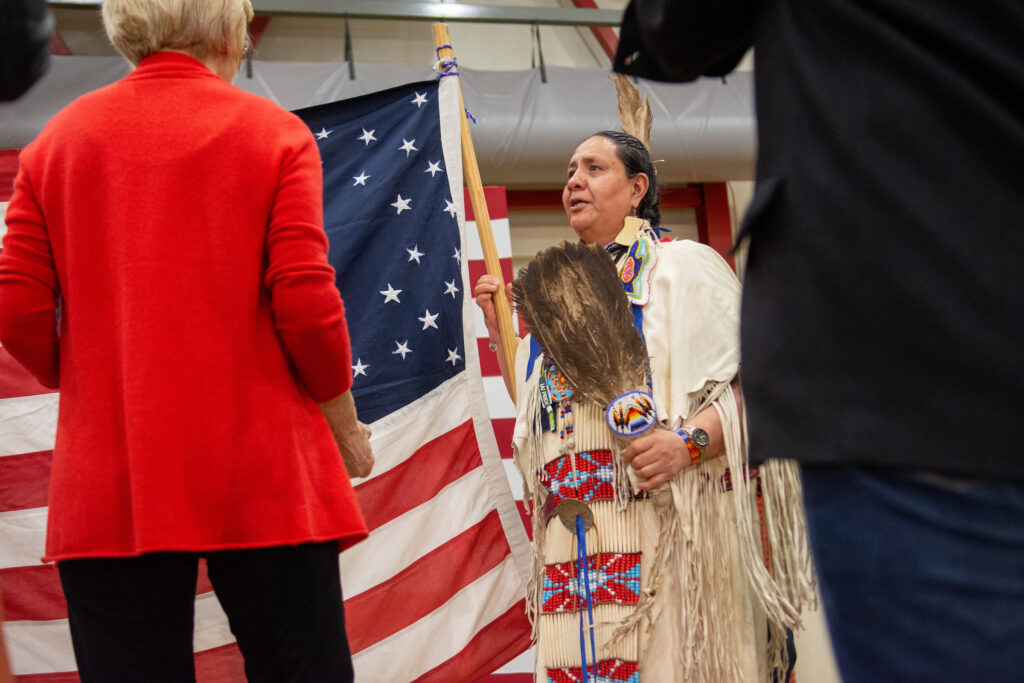
Sanders, speaking at a town hall in Carson City last week, opened with a tirade against the U.S. government and its treatment of Native Americans. It was the first address given by a presidential candidate in Indian Country in Nevada this year.
“Everybody in this room knows the way that the United States government has treated the Native American people from day one is a shame and a disgrace,” Sanders said, addressing a crowd of about 400 that had gathered the Washoe Tribe’s Stewart Community Center. “We need our Native American brothers and sisters to go all over this country and, as president, that’s what I will ask them — to explain sustainability to the American people and to the world.”
Later in the event, the Vermont senator was asked what specifically he would do to help Indigenous families. He launched into another scathing attack of the government, its treatment of the land and its failure to fulfill its treaty obligations. He then pivoted to corporations, which he criticized for only being able to see as far at the end of the financial quarter, where Native communities, he said, consider the impact their actions will have for generations.
“You don’t destroy your source of food. You don’t wipe out the buffalo if you’re dependent upon that for food. You don’t poison the water if you need water to drink,” Sanders said. “That’s what they have understood, and that when you look at your policy, what you do is you look at it over a long period of time, not just the end of the quarter and the profits that you make.”
It was a moment that highlighted the cultural fluency that several Native leaders in Nevada pointed to in interviews when trying to explain why Sanders has such resonance within their communities. The idea Sanders was obliquely referencing is the Native American principle that decisions should be considered in view of the impact that they will have on the next seven generations.
Rulon Pete, the executive director of the Las Vegas Indian Center, isn’t endorsing ahead of the 2020 election. He can’t, by virtue of the nonpartisan outreach to Native voters his organization will conduct over the next year. But, looking at the 2020 field, he said there’s only one candidate that has displayed a “full comprehension” of Native issues.
“That would just be, of course, Senator Sanders,” said Pete, an enrolled member of the Cedar Band of Paiutes and Navajo. “I'm not saying that I'm endorsing any one of them, but I felt like if there were anyone reaching out to Native communities, it would be him.”
Pete spoke on a panel discussion that Sanders hosted at the LGBTQ Center in Las Vegas earlier this year. He also attended a discussion hosted by Valerie Biden Owens, the former vice president’s sister. But he said that he didn’t feel like she, and by extension her brother, had as full of an understanding of the issues as Sanders does.
“It didn't seem genuine to me,” Pete said.
Of the handful of endorsements that have been made by Native community leaders in Nevada, most have gone to Sanders. His most recent was from Thom, the chairman of the Yerington Paiute Tribe, who announced her support for him this week and was named one of his Nevada campaign’s co-chairs.
Thom got to know Sanders during a meeting she attended with Native leaders after a rally at the University of Nevada, Reno in September. During the meeting, they had a chance to share their concerns with the senator, and she said that she was “very impressed” by his understanding of Native issues.
“He said he was going to need our help to make sure [action is taken] with our consent and not just consultation, and that he would be willing to work with Indian County to ensure that treaty rights and other rights are being served sovereign to sovereign,” Thom said.
Earlier this month, Thom took the senator’s wife, Jane Sanders, on a tour of the Anaconda Copper Mine outside of Yerington, which contaminated a toxic groundwater plume that has snaked below homes and toward the tribe’s reservation. They also visited the tribe’s dispensary, toured their health clinic and had a discussion about the disproportionate impact that federal government shutdowns have on tribes.
Sanders campaign officials say this kind of outreach is a natural outgrowth of the senator’s personal interest in tribal communities. But it’s also a byproduct of the staff’s interest and connections on the ground in Nevada.
Early on in the campaign, a staffer and a volunteer made the decision to attend Western Shoshone National Council Chief Johnnie Bobb’s annual peaceful protest and sacred walk in opposition to the construction of a nuclear waste repository at Yucca Mountain. While there, they filmed people talking about their opposition to the nuclear waste dump and, in May, released a video drawing attention to the issue.
Another staffer recently joined an Indigenous walk down a Northern Nevada highway to honor the lives lost in accidents along that road.
“It was really spiritual and provided a lot of clarity to why I’m doing this as a campaign staffer, and I know they appreciated having a campaign staffer there in support,” said Jacob Allen, Sanders’ Northern Nevada political associate.
The campaign has also attended Inter-Tribal Council meetings, hosted a town hall with the Walker River Paiute Tribe in Schurz, had a table at the 27th Elko Band Pow Wow in September and hosted two Native-specific roundtables, including the one at the UNR and a second, smaller gathering in Elko earlier this month. It was directly in response to concerns raised during that meeting that Sanders came out against opening federal land to oil and gas leasing in the Ruby Mountains.
For the campaign, outreach to Indian Country is an end unto itself: It’s important because the tribal community is important. But his team acknowledges it’s at least partly strategic too.
“We are very aware that there will be precincts in rural Nevada that will be majority Native voters, and we want to get as many delegates as we can in every precinct. That means organizing in every corner of the state and that means making sure we are organizing in these neighborhoods and rural areas where these Native folks live,” said Sarah Michelsen, Sanders’ state director. “We did really well in Northern Nevada in 2016. We think the Native vote was probably key to our success then, and we think that’s going to be critical again.”
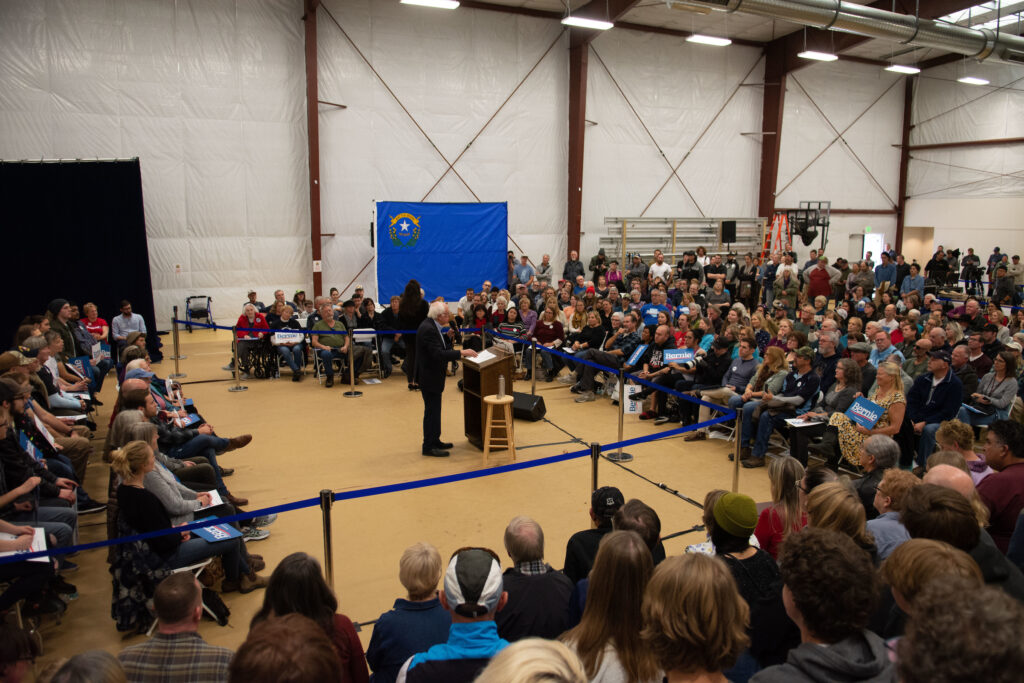
Sanders may be the candidate most often mentioned by tribal leaders in Nevada, but he’s far from the only one focused on Native outreach in the Silver State and nationally.
OJ Seamans, co-director of Four Directions, said one candidate that stood out to him most was Harris. He noted that while she butted heads with tribes as California’s attorney general, after she participated in the August Native American presidential forum, she developed a Native policy on federal lands.
“To me, that showed that people listened at that form because she went from having no idea to actually saying, ‘You know what, this is the right thing to do,’” said Seamans, an enrolled member of the Rosebud Sioux Tribe who is working with Native organizers in Nevada.
Mandell, vice chair of the Pyramid Lake Paiute Tribe, said he first met Harris during a trip she made to Carson City in April. But it was the release of Harris’s Native policy that persuaded him to endorse the California senator for president in October.
“I kind of followed her in California as a neighboring state. I just liked her. And then she came out with a set of Native American policies that she had put out,” Mandell said. “I liked the policy itself.”
Warren’s campaign has engaged in specific Native outreach in Nevada, with staffers speaking at two recent Inter-Tribal Council meetings and participating in community meetings with members of the Walker River Paiute Tribe in Schurz and the Wells Band of the Te-Moak Shoshone Tribe in Wells.
She also released a wide-ranging Native policy in August before her appearance at the Native American presidential forum, and was the first candidate to oppose military expansion into the Desert National Wildlife Refuge, which is sacred land for the Moapa Band of Paiutes, after her staffers met with environmental Native leaders about the issue.
But Warren has another barrier to overcome with the Native community: Her decades-old claim of Native American ancestry and her attempt to back it up with a DNA test. But feelings among the Native community here are far from homogenous on the subject. Some view her actions as egregious and her apologies to the Cherokee Nation superficial. Others are hesitant to judge her background.
“I’m really big on, like, I don’t know people’s backgrounds, and I’m not going to slander anybody if they say they’re part of a community. I don’t know if they are or not,” said Teresa Melendez, a citizen of the Pokagon Band of Potawatomi who is active in Native organizing in Nevada and has endorsed Sanders. “I’ve been giving Warren the benefit of the doubt.”
Other Native leaders have done the same. Haaland, one of the two Native American women in Congress, endorsed Warren in July, and Walker River Paiute Chairman Amber Torres announced her support for the senator in October. Torres did not respond to multiple requests for an interview for this story.
Former Vice President Joe Biden campaign, meanwhile, has former Assembly Speaker John Oceguera in his corner. Oceguera is a member of the Walker River Paiute Tribe and was the first Native American to serve as speaker in the state’s history.
The campaign has been engaging through its political and organizing teams with the Paiute Tribe in Southern and Northern Nevada and the Te-Moak Shoshone Tribe of Western Nevada, which took part in the program for Biden’s town hall in Elko. Biden also has a fellow on staff in Elko from the Te-Moak tribe who is focused on Native engagement and outreach.
South Bend Mayor Pete Buttigieg released his Native plan in October, and his Nevada team has participated in events with the Fallon Paiute-Shoshone Tribe and the Elko Band Colony of the Te-Moak tribe. Just last weekend, Buttigieg organizers were focusing on outreach to the Corn Creek area of the Las Vegas Indian Colony.
Buttigieg’s campaign is also trying to schedule a Native-specific tele-town hall before Nevada’s presidential caucus.
It’s not just the top polling candidates with the biggest staffs that are focusing on Native outreach, either. A spokeswoman for New Jersey Sen. Cory Booker said that Campaign Manager Addisu Demissie met with the president of the Reno-Sparks Indian Colony both in August and October, while Castro and Williamson are two candidates noted for their Native outreach.
Mercedes Krause, an enrolled member of the Oglala Lakota Nation and executive director of United Natives who is active in Native organizing in Southern Nevada, said that during a meeting earlier this year Williamson actually got on her website and started making changes to her policy platform.
“She wanted to learn,” Krause said.
Melendez, who also met with Williamson, described the author’s work as “heart-centered” and said that it falls easily in line with Native epistemology.
“It was a really easy conversation. Like three hours,” Melendez said. “I always enjoy a conversation with Marianne because she gets it at a heart level that people who are entrenched in corporate American and politics sometimes don’t because there’s so much money involved.”
And then there’s Castro, the only presidential candidate to visit the Anaconda Copper Mine himself. He also released a comprehensive Native policy in July and was the second candidate to join Warren in her opposition to the military’s proposed expansion into the Desert National Wildlife Refuge.
Thom drew a parallel between Castro’s Anaconda visit and his tour of the tunnels beneath the Las Vegas Strip to talk with the city’s homeless population.
“When he was down in Vegas, he did visit areas that most candidates don’t go,” Thom said. “He’s really trying to bring forth a lot of those issues to the debate.”
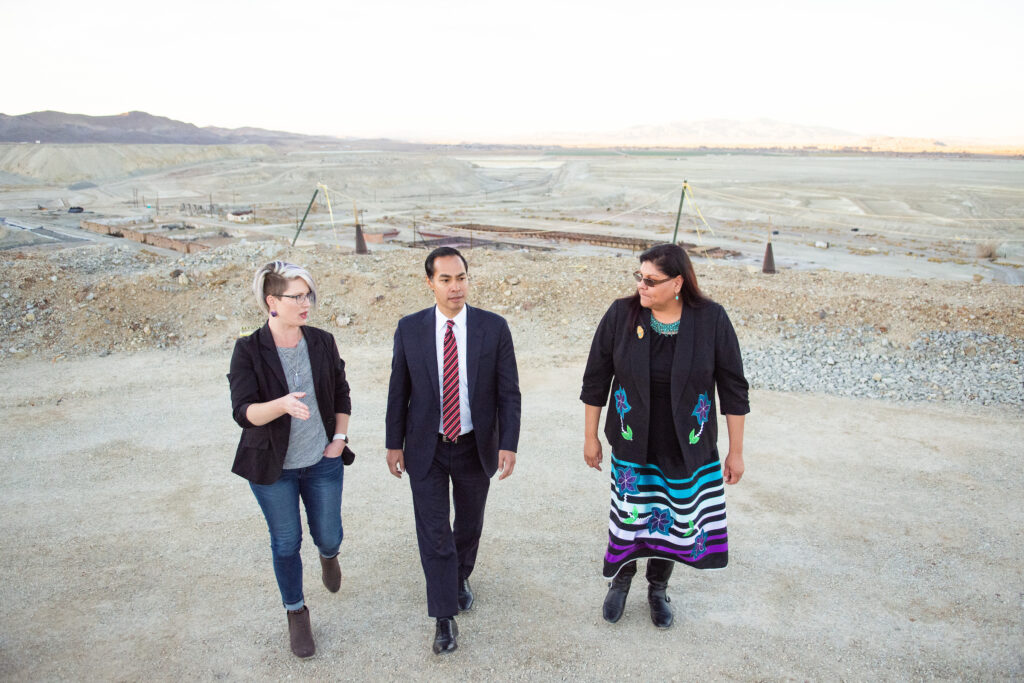
Much has changed in the last four years. Four years ago, Seamans and his group Four Directions were fighting with Secretary of State Barbara Cegavske on the behalf of the Pyramid Lake Paiute Tribe and the Walker River Paiute Tribe.
The tribes argued in a lawsuit that the state of Nevada and Washoe and Mineral counties had violated the Voting Rights Act by denying their requests for polling places on their reservations, citing cost and logistical concerns. In the end, a federal judge sided with the tribes on the grounds that the public interest is served by enforcing the Voting Rights Act and “the inclusion of protected classes in the political process.”
Not only did the tribes get their requested polling sites in Nixon and Schurz, but the case has been used as a precedent in other Native voting rights cases across the country, Seamans said.
On top of that, the Legislature passed a bill, SB492, during the 2017 session codifying the judge’s ruling and requiring county clerks to establish at least one temporary branch polling location on reservations if requested with enough advance notice by the tribes.
“They call it the Silver State. I was calling it the Golden State because of what the Legislature did,” Seamans said. “You won’t find any of the other 50 states has that type of law.”
Other tribal polling sites for the 2016 election included the Moapa Tribal Administrative Building and the Washoe Elder Center and in 2018, there were four — in Nixon, Schurz, Moapa on the Moapa Band of Paiutes reservation and Hungry Valley on the Reno-Sparks Indian Colony reservation. So far, four are confirmed for the 2020 general election — Moapa, Nixon, Hungry Valley and a new site at Reno-Sparks Indian Colony’s #6 Smoke Shop in Spanish Springs.
Seamans said his organization is in the process of having conversations with tribal leaders and informing them about the new law to boost the number of polling sites on reservations ahead of the 2020 election. Under the new law, tribes have until July 3, the first Friday in July, to submit their requests to their respective county clerks.
Allowing voting on reservations is key to boosting the Native vote, because people often don’t have the means to travel 50 or 100 miles to the nearest polling site, Seamans said. Four Directions conducted a survey before they filed their lawsuit and found that members of the Pyramid Lake Paiute Tribe had to travel as many as 70 miles to the nearest polling location, while some wealthy Lake Tahoe residents only had to travel 5 miles to their nearest satellite polling location.
“In our survey, we were able to identify that Natives were in the majority in the poverty level, and their vehicles were not trustworthy to travel long distances or even short distances unless there was some type of emergency,” Seamans said.
That’s something that the Nevada State Democratic Party is taking into consideration as well as it plans caucus sites. The party had caucus sites on reservations in 2016 — including at the Washoe Housing Authority in Gardnerville; the Human Development Center in Owyhee; the Fort McDermitt Paiute and Shoshone Tribal Building; the Walker River Paiute Tribe Community Center in Schurz; the Yomba Shoshone Tribal Gym; and the Pyramid Lake Junior and Senior High School in Nixon — and will do so again in 2020.
The party will also offer early voting at four different locations on reservations, at the Las Vegas Indian Center, the Wadsworth Community Building on the Pyramid Lake Paiute Tribe's reservation, the Hungry Valley Recreation Center and at the Washoe Housing Authority.
The polling location is only one part of the equation, though. The other is getting people to actually show up. But Seamans is optimistic. Data provided by Four Directions shows that early votes from precincts in Nixon in 2016 increased 781 percent over those cast in 2012, and Election Day votes from those precincts increased by 180 percent between the two elections, while overall Washoe County voter turnout only increased by 113.7 percent.
“The data shows that the satellite offices bring in new voters,” Seamans said. “The old voters will continue to come, but over and over the data has shown it produces new voters.”
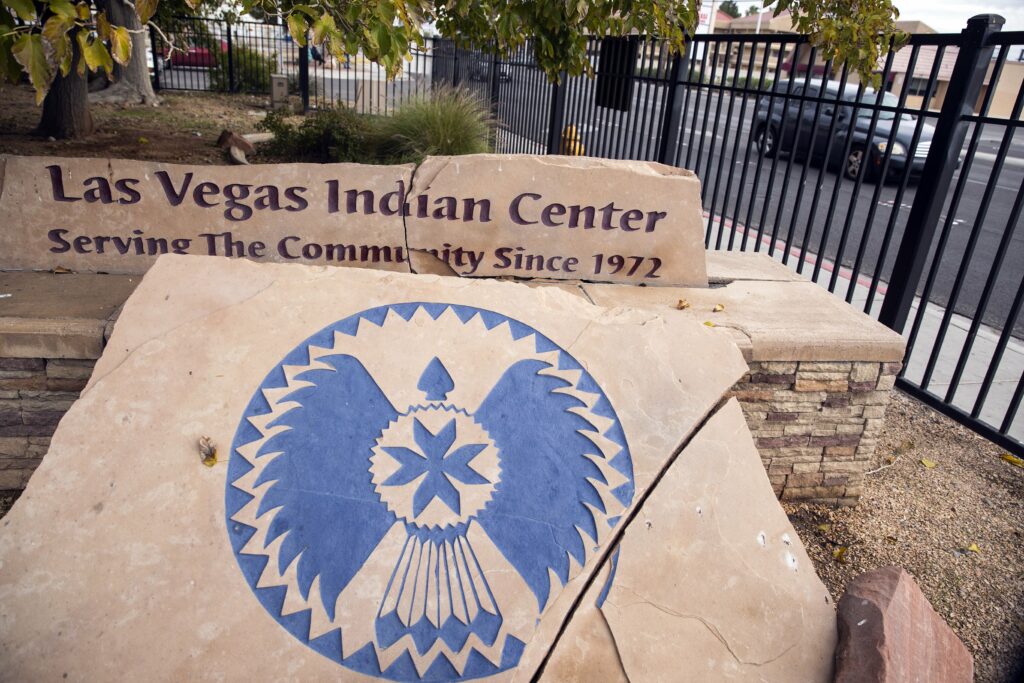
Earlier this year, Teresa Melendez and her husband Brian Melendez had an idea. They were watching a tumultuous political battle playing out on a national level and realized that they wanted the Native community to have a seat at the table. They brought the idea to Sarah Mahler, chair of the Washoe County Democratic Party, who helped them draft and submit bylaws for a new Native American caucus to the state Democratic Party in June.
By October, the state party central committee had overwhelmingly approved them and gave the caucus a seat on the party’s executive board.
“It’s never been done before,” Brian Melendez said.
For Teresa Melendez, it seemed like the natural thing to do. The tribes are a political powerhouse in her home state of Michigan.
“I was blown away when I moved to Nevada,” she said. “The tribes do not have political influence here.”
People only recognize the tribes, she said, when they have money and numbers. That means it’s usually the big gaming tribes that have earned the lion’s share of the attention.
But the couple is hoping to change that. Their short term goals include recruiting Native seats in the state central committee and boosting voter turnout for the 2020 presidential election. Longer term goals include building a bench of Natives interested in running for local, state and national offices, Teresa Melendez said.
And they’re not the only ones. Tribal leaders and Native organizers across the state are ramping up in a number of ways — from voter registration drives and caucus trainings to a presidential candidate forum — in an effort to turn out the biggest Native vote ever in 2020.
“It seems to be the consensus that we are organizing in our pockets with the same ideas, the same goals toward having the Native voice heard, and then we're starting to connect across the state and across the country now because we are all feeling and experiencing similar things,” said Krause, who has drafted the bylaws and recruited an executive board to form a Clark County Native caucus. “So it's kind of happening simultaneously, but now everything is linking up.”
Those pockets will officially converge on Jan. 14 and 15 when tribes from across the state and the country come together to hear from and share their concerns with presidential candidates, educate each other and come up with a game plan ahead of the 2020 election at the Native American presidential forum at UNLV.
“The Native vote in Nevada is a swing vote,” LeBlanc said. “It’s a critical vote that needs to be educated and mobilized, and these forums provide an opportunity for the first time in history for presidential candidates to state their positions on various issues of concern in Indian Country and to be educated about what the voters and the leadership both tribal and community.”
The concern for organizers now is who will actually show up. The Democratic National Committee scheduled its January Democratic presidential debate for Jan. 14 in Iowa. But Seamans is hopeful that they will be able to convince several of the presidential hopefuls to appear via live stream, as they did during the last forum.
The forum itself, he said, will begin with a discussion between the descendants of Wovoka, a prophet from the Northern Paiute Tribe responsible for the spread of the Ghost Dance movement, and the descendants of Wounded Knee, the massacre of hundreds of Lakota men, women and children by the U.S. Army in 1890 and after which the movement was sent underground.
“We’re going to pick up something our ancestors started 130 years ago by having the tribes unite for hope,” Seamans said. “This time it’s going to be for the 2020 election.”
In addition to presidential candidate appearances, the event will feature panels on Native voting, education, the environment and economic development, among other issues.
The forum will also include Native-specific caucus training, which, Seamans said, will include an emphasis on how to advocate in a caucus situation. During the caucus, attendees typically have a chance to persuade people to back their preferred candidate during a so-called realignment period.
“Natives have, forever and ever, not dominated conversation. They usually sit back. They do a lot of listening, but they’re not ones to jump into the middle of an argument and convince them to do something else. It’s just not in our culture,” Seamans said. “That’s going to be the toughest part of the training is to be able to get them to stand up and speak their minds especially to non-Natives. That’s always been difficult culture-wise.”
Some of the individual tribes are planning their own outreach efforts too. Arlan Melendez, chairman of the Reno-Sparks Indian Colony, said that they are currently having conversations about going house to house to register their members to vote, and not just at powwows and special events. He said that their reservation can be walked in a couple of hours, compared to other tribes whose reservations are more spread out.
But for all the polling locations, voter registration drives and caucus trainings, at the end of the day, the most significant hurdle is this: Convincing Natives to exercise their right to vote to shape the future of a government that has too often ignored their needs and actively threatened their way of life.
“Most tribes, tribal members, we’re not Democrat or Republican per se, but we look to the government to uphold their obligations to the tribes,” said Ted Howard, chairman of the Shoshone-Paiute Tribes of the Duck Valley Indian Reservation, whose reservation spans the Idaho-Nevada border. “I think from both sides we have not really seen that level of protection from the government.”
Howard says it’s hard to get excited about things these days. There’s so much uncertainty, he says. But he’s encouraged by the outreach by some of the Democratic presidential hopefuls to Native communities.
“It’s not something that’s happened before,” Howard said. “I think we’re cautiously optimistic.”
